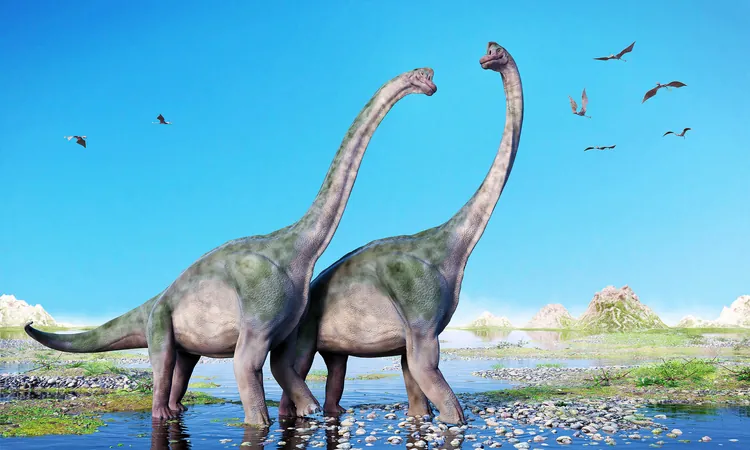
Unraveling the Mysteries of Dinosaur Mating: Fossil Clues and Modern Comparisons Provide Intriguing Insights
2025-01-25
Author: Yan
Dinosaurs, the colossal creatures that once roamed our planet, left behind a treasure trove of fossils - bones, footprints, and other remnants that tell us about their lives and survival strategies. However, one of the most intriguing puzzles baffling scientists for over a century is how these magnificent beasts engaged in mating and reproduction.
The Quest for Understanding Dinosaur Intimacy
While paleontologists have made great strides in understanding dinosaur diets, growth patterns, and behaviors, the details surrounding their mating rituals remain elusive. Ms. Riley Black, a renowned American paleontologist, has been vocal about the curiosity surrounding this subject, pointing out that evidence of reproductive organs like a phallus or clitoris has yet to be discovered.
Insights from Fossil Evidence
The fossil record provides limited direct evidence regarding dinosaur mating, as reproductive organs are rarely preserved. Nevertheless, scientists have found indirect clues, such as scrape marks in the ground believed to be mating grounds identified by a team led by Martin Lockley in 2016. These marks provide a snapshot of pre-mating behaviors and suggest that courtship rituals may have been integral to dinosaur interactions.
Imagine these rituals as prehistoric equivalents of modern-day courtship, where dinosaurs displayed particular behaviors to attract potential mates. Such findings further emphasize the connections between dinosaur reproductive habits and those of modern birds and crocodilians, their closest living relatives.
Drawing Parallels with Modern Creatures
Birds, thought to be direct descendants of certain dinosaur lineages, exhibit a range of mating behaviors that may parallel those of their prehistoric ancestors. Interestingly, some species of birds possess visible reproductive organs, while others have hidden anatomy, similar to how male crocodilians conceal their penises within a cloaca. This lends credence to the hypothesis that dinosaurs may have had similar reproductive traits.
The Mechanics of Dinosaur Copulation
Dr. Beverly Halstead's research suggests that dinosaurs generally employed familiar mating positions. Most species likely had males mounting females from the rear, using their forelimbs for support. While this sounds straightforward, it raises questions about how enormous dinosaurs, specifically the sauropods, managed to mate without endangering each other's safety.
Interestingly, researchers propose that the stress incurred during mating would not surpass the normal wear and tear experienced in daily activities such as walking or running, thus suggesting that mating could be less perilous than it seems.
New Discoveries in Dinosaur Parenting
Significant breakthroughs extend beyond mating to parenting. Notably, scientists discovered medullary tissue within the thighbone of a pregnant Tyrannosaurus rex. This tissue formation is akin to that found in modern birds just prior to egg-laying. This discovery not only suggests a closer evolutionary link between dinosaurs and birds but also offers insights into their reproductive timeline.
The Role of Environment in Mating Habits
Open questions linger about how dinosaurs with prominent armor and heavy plating, like stegosaurs, managed mating without injury. Moreover, the possibility that significant dinosaur species required aquatic environments for buoyancy during mating poses another layer of complexity.
Future Directions in Paleontological Research
As paleontologists continue to adapt to technological advancements, new methodologies such as computer modeling, synchrotron scanning, and CT imaging are paving the way for deeper exploration into dinosaur mating behaviors. Researchers are hopeful that the continuing uncovering of fossil sites will eventually yield a clearer understanding of how these prehistoric giants engaged in reproduction.
The Promise of Future Discoveries
Though a definitive look at dinosaur intimacy remains a tantalizing prospect, paleontologists are optimistic that the secrets to their private lives lie just beneath the surface of ancient rocks, ready to reshape our understanding of how these formidable creatures evolved and thrived in their ever-changing environment.
As the exploration of dinosaur mating rituals progresses, one can only imagine the groundbreaking revelations that await us, potentially transforming our comprehensions of their behavior and biology for years to come.



 Brasil (PT)
Brasil (PT)
 Canada (EN)
Canada (EN)
 Chile (ES)
Chile (ES)
 Česko (CS)
Česko (CS)
 대한민국 (KO)
대한민국 (KO)
 España (ES)
España (ES)
 France (FR)
France (FR)
 Hong Kong (EN)
Hong Kong (EN)
 Italia (IT)
Italia (IT)
 日本 (JA)
日本 (JA)
 Magyarország (HU)
Magyarország (HU)
 Norge (NO)
Norge (NO)
 Polska (PL)
Polska (PL)
 Schweiz (DE)
Schweiz (DE)
 Singapore (EN)
Singapore (EN)
 Sverige (SV)
Sverige (SV)
 Suomi (FI)
Suomi (FI)
 Türkiye (TR)
Türkiye (TR)
 الإمارات العربية المتحدة (AR)
الإمارات العربية المتحدة (AR)